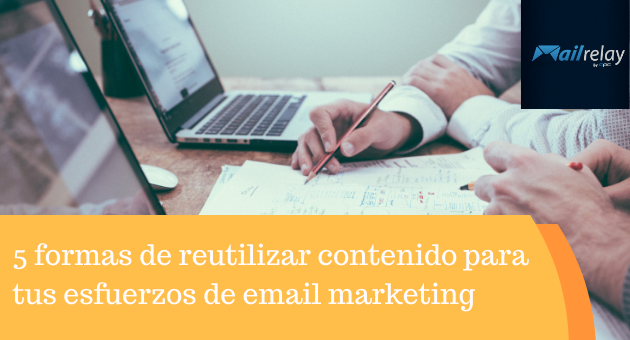
As a content marketer, blogger, or as someone with an online audience, you know how hard it is to come up with content ideas. Sure, you have inspiration strike, and it can keep you going for a long time, but sometimes the creative well dries up and you’re left looking under stones for the best idea.
However, have you considered repurposing your content? Think of all the blogs and social media content you’ve already created. By repurposing this content, you’re taking the core concepts of your content and turning it into something else. Whether you’re giving this content to a different niche in your audience, or just giving them something new to enjoy, repurposing can be a content creators best friend.
Of course, that doesn’t mean taking an existing blog and simply turning it into a new blog that says the same thing; you need to portray it in a different way, such as taking blog content and turning it into email content, which is exactly what we’re going to look at today.
Why Create Email Marketing Content?
In a world seemingly dominated by social media, blog posts, and webinars, there’s no denying that email marketing is still one of the most effective ways of communicating with your audience on an individual and personal basis.
With an average ROI of $42 for every $1 spent on email marketing and over 4.3 billion email users forecasted by the time we get to 2023, email marketing is where it’s at. If you’re not already implementing this channel into your marketing strategy, you’re missing out. If you are using it, you’ll already know how hard it is to create content that resonates with your mailing list.
This is where repurposing comes in. By taking already successful content from your social media pages and websites, you can create marketing emails that get results and drive your business further into the realms of success.
As we said above, you don’t want to simply repost your content. That’s just lazy. It’s about repurposing your message into new, viable forms of communication that say what you want to say. Here are five creative ways you can do just that.
Case Studies, Social Proof, and Testimonials
Some of the best content that businesses forget they have to use is their social proof. This could be comments on a social media post, a review on their product or Google business page, or any kind of testimonial you may have gathered throughout your time operating as a business.
There’s a lot you can do with this kind of content. Even just sharing an email with what people have said about you is a great way to garner attention to what you do. According to statistics, 92% of consumers will trust non-paid recommendations (such as online reviews) more than any other type of advertising. This is how powerful social proof is.
After all, would you ever go online to Amazon and buy a one-star product? Probably not. The same applies to your business. Of course, showing off your business with all the amazing reviews you’re getting may seem a bit egotistical, so why not dress it up in an exciting way?
For example, get people to leave reviews to win a chance at being featured in your monthly email. All the winners picked will win a discount code or a short prize. That’s easy yet powerful content and next-to-no expense to you. Plus, you get a ton of feedback from your customers, which is useful in all kinds of ways.
The second approach you can take is creating case studies. Case studies are so important in business because it takes a deep dive into a customer’s story on an individual level, meaning customers can relate and resonate far clearer than any other form of advertising.
For example, let’s say you’re selling a TV. Instead of listing off the features, like the sound system and the number of pixels, create a character and follow their story on the experience your television provided in their own lives.
Show how Darren got your new set and was blown away watching his favourite actions movies with the incredible detail and mind-blowing sound that made him feel as though he was right there in the action. And, of course, all his friends and family were jealous and wanted one of themselves.
“Creating stories like this, whether fabricated or based on real-life customer reviews, is the best way to connect with your audience and have them relate to your messages. Nobody wants to be preached at, so instead of bombarding people with lists of features, give them the information in a much more compelling way,” explains Sarah Taylor, a tech writer at Research Paper Writing Service and Paper Fellows.
Video Emails
Video content is king right now, and you only have to go on the Explore tab of your preferred social media platform to see that video content is everywhere, and it’s the most engaging and interacted with form of content. There’s no denying this, and if you’re not already using video content in your marketing efforts, now is the time to do so.
However, how can you incorporate this content into your email content? Well, in lots of different ways. The most obvious way is to simply link to your social video content. Of course, emails don’t tend to play in most email browsers, so instead take a screenshot of the video play screen with the play button over the top.
This will naturally show users that video content can be found here, and upon clicking on the image, they’ll be taken to your social video. This could be hosted on a website like YouTube, or content on your landing pages or social media; it’s completely up to you.
Don’t forget that you’ll need to add the term ‘video’ into your email subject line to attract attention and will massively boost your open rates.
Sharing Social Media Highlights
Take a look at your social media pages and take a moment to see which of your posts are the most successful, both in terms of views and engagement. The highest figures clearly mean that you’re invoking conversations within your community, and your content is truly resonating with your readers.
That being said, take these highest performing posts and share them with your wider audience through emails. There are also plenty of creative ways you can do this. Firstly, you can share your posts as social media highlights. You could do this on a weekly, two weekly, or monthly basis (preferably the latter because you don’t want to spam your readers).
By including highlights of maybe your five most popular posts, depending on how often post, you can keep people in the loop easily and ensure everyone knows what you’re talking about.
On the other hand, you could take your highest posts and create entire emails based on a single post. Expand on what you’ve been saying and invite people to join in the conversation. This is a great way to not only share content with people but also to draw people on your mailing list who may not be following you already to then check out your social media pages.
Daily Bitesize Info Chunks
Hand in hand with the consideration above about social media posts, instead of providing them with a full-on guide going in-depth with the content you’re sharing, why not provide your users with daily info chunks. Of course, you’re not going to want to post the same content on both social media and within your emails on the same day, so try and mix it up a bit.
Maybe scroll back down your Instagram feed or Twitter and check out some of the older posts you’ve written. This is especially effective if you post quotes or statistics or data bites for people to consume. Use the most compelling content you can for the best results.
Transform Presentations into Infographics
“If you work with presentations, such as holding events or online webinars or even online courses, take the information from your presentations and take the key points to share within your email content. Not only can this be a great way to attract people to your other content, but you can also be providing them real value into their everyday lives,” shares Peter Johnson, an email marketer at Boomessays and Essay Help.
A great way to do this, as the subheading suggests, is to create an infographic. Sure, infographics may take a bit longer to produce than most other forms of content, but they really are timeless when it comes to engagement.
Infographics tend to have one of the longest lifespans of all online content, and they’re extremely shareable, especially if your content is relatable. As you probably know from experience, infographics can be read easily and quickly via scanning or can provide in-depth information if required.
Easily digestible content like this is precisely what you should include in email content, so take advantage of what content you’ve got and turn it into something beautiful.
Beatrix Potter is a marketer at Write my admission essay and Finance essay help. She writes about content recycling. She also is a manager at Essayroo.com website.
